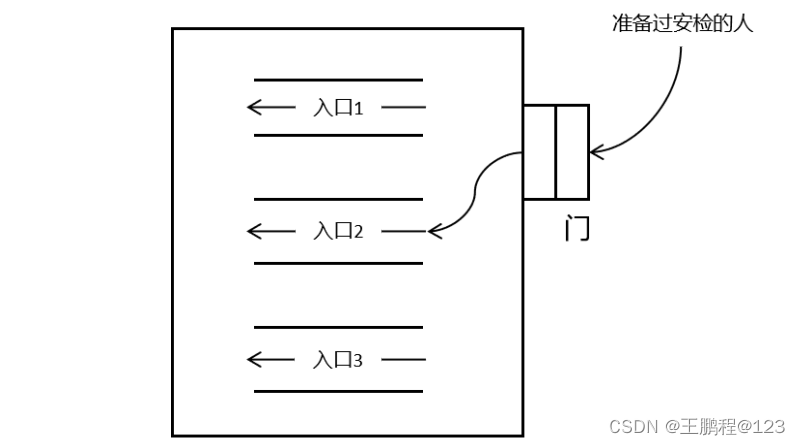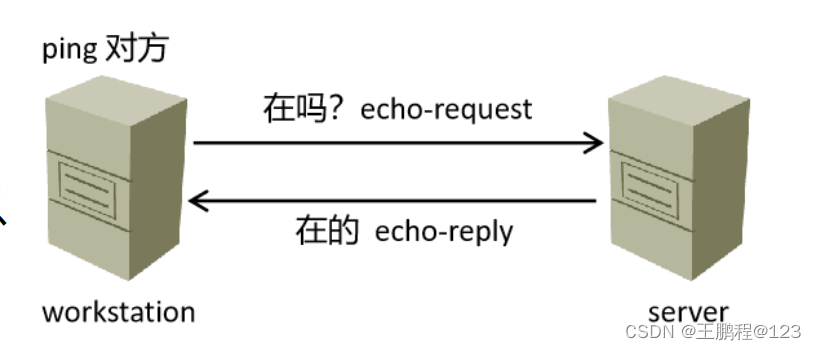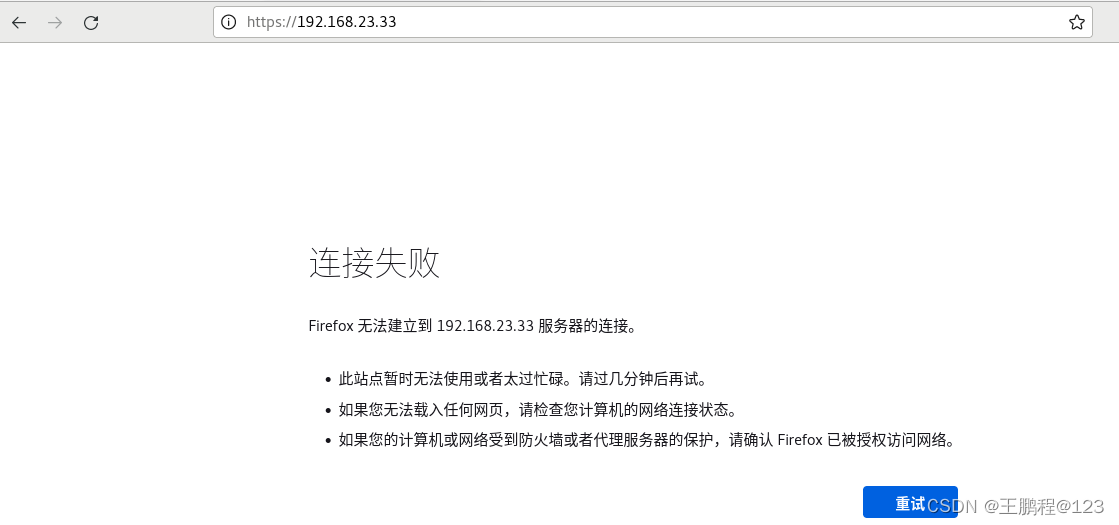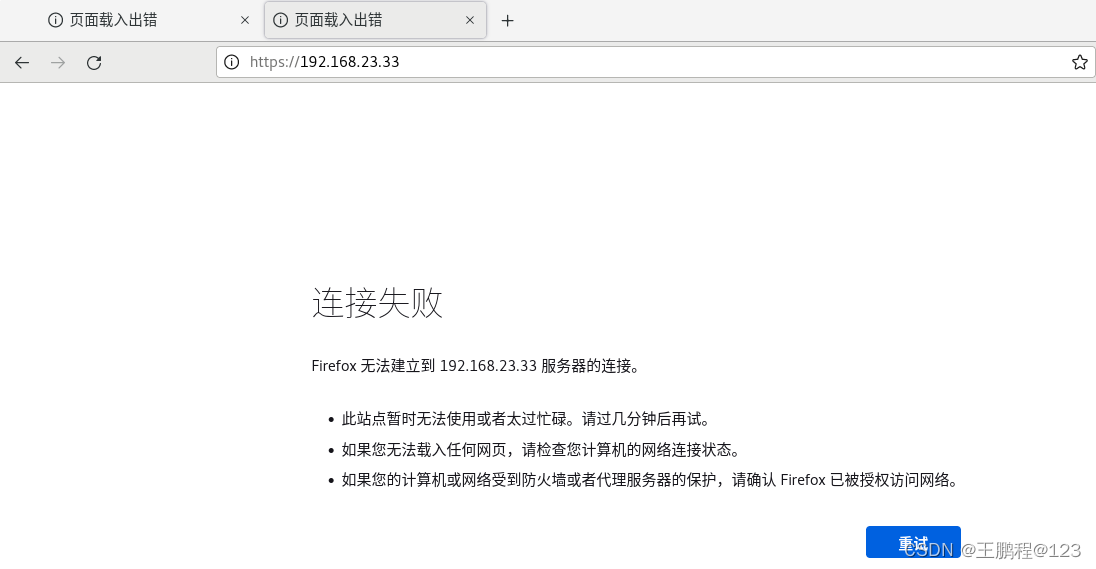Linux防火墙---firewall详解
本章主要介绍RHEL8中的firewalld的配置。
- firewalld中的名词介绍
- firewalld的基本配置配置
- firewalld的规则添加
- firewalld的富规则
了解 firewalld?
在RHEL8中用的防火墙是firewalld,在 firewalld中又涉及zone的概念。首先来了解一下什么是zone。?
如在进地铁或高铁时需要安检,安检有不同的入口,如下图所示。

以安检入口举例?
不同的入口严格度不一样,有的入口大包小包都要检测;有的入口只要检测大包即可,背包或单肩包就不用检测了;有的入口是绿色通道,不用检测直接通过。这里不同的安检入口制定了不同的规则。?
同理,firewalld中的zone我们就理解为如上的安检入口,不同的zone中制定了不同的规则。某网卡要和某一个zone进行关联,如下图所示,ens160和 zone2进行关联,这样从网卡ens160进来的数据包都要使用zone2中的过滤规则。?
 ?了解firewall中的zone
?了解firewall中的zone
网卡是不能同时和多个 zone关联的,最多只能和一个 zone关联。如果网卡没有和任何 zone关联,则使用默认的zone中的规则。?
firewalld的基本配置?
查看系统中有多少个 zone,命令如下。?
[root@rhel03 ~]# firewall-cmd --get-zones
block dmz drop external home internal libvirt nm-shared public trusted work
[root@rhel03 ~]#
在这许多的zone中,其中 block拒绝所有的数据包通过,trusted允许所有的数据包通过。所以,如果把网卡和 trusted关联,则来自这张网卡的数据包都能通过。?
查看系统默认的 zone,命令如下。?
[root@rhel03 ~]# firewall-cmd --get-default-zone
public
[root@rhel03 ~]#
可以看到,默认的zone是 public。
把默认的zone修改为trusted,命令如下。?
[root@rhel03 ~]# firewall-cmd --set-default-zone=trusted
success
[root@rhel03 ~]# firewall-cmd --get-default-zone
trusted
[root@rhel03 ~]#再次把默认的zone改成public,命令如下。?
[root@rhel03 ~]# firewall-cmd --set-default-zone=public
success
[root@rhel03 ~]# firewall-cmd --get-default-zone
public
[root@rhel03 ~]# 查看网卡ens160和哪个zone关联,命令如下。?
[root@rhel03 ~]# firewall-cmd --get-zone-of-interface=ens160
public
[root@rhel03 ~]# 可以看到,网卡 ens160是和public关联的。
把网卡加入某个 zone,语法如下。?
- firewall‐cmd ‐‐add‐interface=网卡名 ‐‐zone=zone 名?
如果不指定zone名,则是默认的zone。
把ens160和home这个 zone关联,命令如下。?
[root@rhel03 ~]# firewall-cmd --add-interface=ens160 --zone=home
Error: ZONE_CONFLICT: 'ens160' already bound to a zone
[root@rhel03 ~]#
一张网卡只能在一个zone中,这里可以看到ens160已经属于一个zone了,所以发生了冲突。?
可以先把网卡从public中删除,然后重新添加,这里把ens160 从 public中删除,命令如下。?
[root@rhel03 ~]# firewall-cmd --remove-interface=ens160 --zone=public
success
[root@rhel03 ~]# firewall-cmd --get-zone-of-interface=ens160
no zone
[root@rhel03 ~]#这样ens160就不属于任何zone了,如果不属于任何zone,则使用默认的zone中的规则。?
然后把 ens160加入 home中,命令如下。?
[root@rhel03 ~]# firewall-cmd --add-interface=ens160 --zone=home
success
[root@rhel03 ~]# firewall-cmd --get-zone-of-interface=ens160
home
[root@rhel03 ~]# 以后ens160会使用home中的规则,不再使用public中的规则。先从 zone中删除,然后再添加到其他的zone 中,这个过程可以用一条命令替换,命令如下。?
[root@rhel03 ~]# firewall-cmd --change-interface=ens160 --zone=public
success
[root@rhel03 ~]#这里的意思是把ens160切换到public这个zone,如果不指定zone,则是默认的zone, 命令如下。?
[root@rhel03 ~]# firewall-cmd --get-zone-of-interface=ens160
public
[root@rhel03 ~]#
后面的练习均是在public 中做。
配置firewalld的规则?
网卡在哪个zone中就使用那个zone 中的规则,如果网卡不属于任何zone,则使用默认的zone中的规则。?
一个zone中的规则可以通过“firewall-cmd --list-all --zone=zone名”来查看,如果不指定zone,则是默认的zone.?
现在查看 public这个 zone中的规则,命令如下。
[root@rhel03 ~]# firewall-cmd --list-all --zone=public
public (active)
target: default
icmp-block-inversion: no
interfaces: ens160
sources:
services: cockpit dhcpv6-client mountd nfs rpc-bind ssh
ports: 123/udp 323/udp 20-21/tcp 10010-10020/tcp
protocols:
forward: no
masquerade: no
forward-ports:
source-ports:
icmp-blocks:
rich rules:
[root@rhel03 ~]#
因为默认的zone就是 public,所以这里即使不加--zone=public选项,显示的也是 public这个zone中的规则。?
我们看一下最常用的一些设置。
icmp-blocks?
平时测试网络通或不通是用ping进行测试的,使用的是 icmp 协议,如下图所示。
 ?ping的过程
?ping的过程
icmp有很多类型的数据包,ping的时候用的是以下两种。?
- echo-request:我ping对方时发出去的包。
- echo-reply:对方回应我的包。?
一共有多少种类型的icmp包,可以通过“firewall-cmd --get-icmptypes”来查看。 在rhel03上执行 tcpdump命令进行抓包,命令如下。?
[root@rhel03 ~]# tcpdump -i ens160 icmp
dropped privs to tcpdump
tcpdump: verbose output suppressed, use -v or -vv for full protocol decode
listening on ens160, link-type EN10MB (Ethernet), capture size 262144 bytes
在rhel04上ping rhel03的IP两次,命令如下。?
[root@rhel04 ~]# ping 192.168.23.33 -c2
PING 192.168.23.34 (192.168.23.34) 56(84) bytes of data.
64 bytes from 192.168.23.34: icmp_seq=1 ttl=64 time=0.055 ms
64 bytes from 192.168.23.34: icmp_seq=2 ttl=64 time=0.089 ms
--- 192.168.23.34 ping statistics ---
2 packets transmitted, 2 received, 0% packet loss, time 1001ms
rtt min/avg/max/mdev = 0.055/0.072/0.089/0.017 ms
[root@rhel04 ~]# 然后到rhel03上查看,命令如下。?
[root@rhel03 ~]# tcpdump -i ens160 icmp
dropped privs to tcpdump
tcpdump: verbose output suppressed, use -v or -vv for full protocol decode
listening on ens160, link-type EN10MB (Ethernet), capture size 262144 bytes
11:19:13.367888 IP 192.168.23.34 > rhel03: ICMP echo request, id 1896, seq 1, length 64
11:19:13.368001 IP rhel03 > 192.168.23.34: ICMP echo reply, id 1896, seq 1, length 64
11:19:14.374796 IP 192.168.23.34 > rhel03: ICMP echo request, id 1896, seq 2, length 64
11:19:14.374928 IP rhel03 > 192.168.23.34: ICMP echo reply, id 1896, seq 2, length 64
^C
4 packets captured
4 packets received by filter
0 packets dropped by kernel
[root@rhel03 ~]#
这里rhel04往rhel03发送了两个echo-request包,rhel03均回应了echo-reply包。 在rhel03上用防火墙设置拒绝别人发过来的echo-request包,命令如下。?
[root@rhel03 ~]# firewall-cmd --add-icmp-block=echo-request
success
[root@rhel03 ~]# firewall-cmd --list-all
public (active)
target: default
icmp-block-inversion: no
interfaces: ens160
sources:
services: cockpit dhcpv6-client mountd nfs rpc-bind ssh
ports: 123/udp 323/udp 20-21/tcp 10010-10020/tcp
protocols:
forward: no
masquerade: no
forward-ports:
source-ports:
icmp-blocks: echo-request
rich rules:
[root@rhel03 ~]# 此时,rhel03就不再接收别人发过来的echo-request包了,然后到rhel04再次ping,命 令如下。?
[root@rhel04 ~]# ping 192.168.23.33 -c2
PING 192.168.23.33 (192.168.23.33) 56(84) bytes of data.
From 192.168.23.33 icmp_seq=1 Packet filtered
From 192.168.23.33 icmp_seq=2 Packet filtered
--- 192.168.23.33 ping statistics ---
2 packets transmitted, 0 received, +2 errors, 100% packet loss, time 1007ms
[root@rhel04 ~]#
可以看到,在rhel04上已经 ping不通rhel03了。?
如果要想继续ping操作,就取消对应的设置,命令如下。?
[root@rhel03 ~]# firewall-cmd --remove-icmp-block=echo-request
success
[root@rhel03 ~]# services?
两台主机通信必须使用某个协议,例如,浏览器访问网站用的是http,远程登录到Linux 服务器用的是ssh 协议等。?
默认情况下,public这个 zone只允许很少的服务通过,如下所示。?
[root@rhel03 ~]# firewall-cmd --list-all
public (active)
target: default
icmp-block-inversion: no
interfaces: ens160
sources:
services: cockpit dhcpv6-client mountd nfs rpc-bind ssh
ports: 123/udp 323/udp 20-21/tcp 10010-10020/tcp
protocols:
forward: no
masquerade: no
forward-ports:
source-ports:
icmp-blocks:
rich rules:
[root@rhel03 ~]#
可以看到,这里没有允许http通过。如果要查看防火墙是否开放了某个协议,也可以通过如下语法来查看。?
- firewall‐cmd ‐‐query‐service=服务名?
要获取系统所支持的所有服务,可以通过如下命令来查看。?
[root@rhel03 ~]# firewall-cmd --get-services
RH-Satellite-6 RH-Satellite-6-capsule amanda-client amanda-k5-client amqp amqps apcupsd audit bacula bacula-client bb bgp bitcoin bitcoin-rpc bitcoin-testnet bitcoin-testnet-rpc bittorrent-lsd ceph ceph-mon cfengine cockpit collectd condor-collector ctdb dhcp dhcpv6 dhcpv6-client distcc dns dns-over-tls docker-registry docker-swarm dropbox-lansync elasticsearch etcd-client etcd-server finger foreman foreman-proxy freeipa-4 freeipa-ldap freeipa-ldaps freeipa-replication freeipa-trust ftp galera ganglia-client ganglia-master git grafana gre high-availability http https imap imaps ipp ipp-client ipsec irc ircs iscsi-target isns jenkins kadmin kdeconnect kerberos kibana klogin kpasswd kprop kshell kube-apiserver ldap ldaps libvirt libvirt-tls lightning-network llmnr managesieve matrix mdns memcache minidlna mongodb mosh mountd mqtt mqtt-tls ms-wbt mssql murmur mysql nbd nfs nfs3 nmea-0183 nrpe ntp nut openvpn ovirt-imageio ovirt-storageconsole ovirt-vmconsole plex pmcd pmproxy pmwebapi pmwebapis pop3 pop3s postgresql privoxy prometheus proxy-dhcp ptp pulseaudio puppetmaster quassel radius rdp redis redis-sentinel rpc-bind rquotad rsh rsyncd rtsp salt-master samba samba-client samba-dc sane sip sips slp smtp smtp-submission smtps snmp snmptrap spideroak-lansync spotify-sync squid ssdp ssh steam-streaming svdrp svn syncthing syncthing-gui synergy syslog syslog-tls telnet tentacle tftp tftp-client tile38 tinc tor-socks transmission-client upnp-client vdsm vnc-server wbem-http wbem-https wsman wsmans xdmcp xmpp-bosh xmpp-client xmpp-local xmpp-server zabbix-agent zabbix-server
[root@rhel03 ~]#再次验证http是否被firewall允许,命令如下。?
[root@rhel03 ~]# firewall-cmd --query-service=http
no
[root@rhel03 ~]# 在rhel03上通过yum install httpd -y安装httpd包,启动服务并写一些测试数据,命令如下。?
[root@rhel03 ~]# yum -y install httpd
[root@rhel03 ~]# systemctl start httpd
[root@rhel03 ~]# echo "1234" > /var/www/html/index.html
[root@rhel03 ~]# cat /var/www/html/index.html
1234
[root@rhel03 ~]#然后在宿主机上用浏览器访问rhel03(IP地址是192.168.23.33),结果如下图所示。?

测试宿主机能不能访问?
可以看到,现在根本访问不了,这是因为rhel03上的防火墙并不允许http的数据包通过,然后在防火墙中开放http,命令如下。?
[root@rhel03 ~]# firewall-cmd --add-service=http
success
[root@rhel03 ~]# firewall-cmd --query-service=http
yes
[root@rhel03 ~]#再次打开浏览器验证,结果如下图所示。
 ?
?
此时可以正常打开了。如果要从防火墙中把此服务删除,则可用--remove-service选项, 命令如下。?
[root@rhel03 ~]# firewall-cmd --remove-service=http
success
[root@rhel03 ~]# firewall-cmd --query-service=http
no
[root@rhel03 ~]# 此时浏览器中是访问不了192.168.23.33的。?
ports?
前面介绍了对服务进行过滤与放行,这些服务使用的都是标准端口,例如,http对应的是端口80,ssh对应的是端口22等。?
但有时服务使用的是一个非标准端口,例如,把服务httpd的端口更改为8080。如果在防火墙中只是放行http这个服务,本质上就是放行了端口80,此时用户肯定是访问不到Web服 务的,因为只能通过端口8080才能访问到Web 服务。下面做一下这个实验。?
先临时关闭SELinux,命令如下。?
[root@rhel03 ~]# setenforce 0
[root@rhel03 ~]# getenforce
Permissive
[root@rhel03 ~]#确保SELinux是处在Permissive模式的。?
用如下命令把 httpd的端口替换为8080,并重启httpd服务,命令如下。?
[root@rhel03 ~]# sed -i '/^Listen/cListen 8080' /etc/httpd/conf/httpd.conf
[root@rhel03 ~]# systemctl restart httpd
[root@rhel03 ~]# netstat -anpt | grep httpd
tcp6 0 0 :::8080 :::* LISTEN 3761/httpd
[root@rhel03 ~]#首先在防火墙中放行http,命令如下。?
[root@rhel03 ~]# firewall-cmd --add-service=http
success
[root@rhel03 ~]#在浏览器中访问192.168.23.33:8080,结果如下图所示。?
 ?可以看到,访问失败,因为放行http也只是允许端口80而非端口8080。?
?可以看到,访问失败,因为放行http也只是允许端口80而非端口8080。?
把 http服务从防火墙中删除,命令如下。?
[root@rhel03 ~]# firewall-cmd --remove-service=http
success
[root@rhel03 ~]#下面开始放行端口,常用的语句如下。
- firewall-cmd --query-port=N/协议:查询是否开放了端口N。
- firewall-cmd --add-port=N/协议:开放端口N。
- firewall-cmd --remove-port=N/协议:删除端口N。这里的协议包括TCP、UDP 等。?
在防火墙中添加端口,也可以添加一个范围。例如,要在防火墙中开放1000~-2000范围的端口,可以用如下命令。?
[root@rhel03 ~]# firewall-cmd --add-port=1000-2000/tcp
success
[root@rhel03 ~]#这里“-”表示到的意思。
下面把端口8080放行,命令如下。?
[root@rhel03 ~]# firewall-cmd --add-port=8080/tcp
success
[root@rhel03 ~]# firewall-cmd --query-port=8080/tcp
yes
[root@rhel03 ~]#然后再次在浏览器中访问,结果如下图所示。

防火墙放行之后就能访问了?
防火墙放行之后就能访问了
在防火墙中删除此端口,命令如下。?
[root@rhel03 ~]# firewall-cmd --remove-port=8080/tcp
success
[root@rhel03 ~]# firewall-cmd --query-port=8080/tcp
no
[root@rhel03 ~]#下面把环境还原,再次开启SELinux,确保状态为Enforcing模式,命令如下。?
[root@rhel03 ~]# setenforce 1
[root@rhel03 ~]# getenforce
Enforcing
[root@rhel03 ~]#再次把httpd的端口改为80,并重启服务,命令如下。
[root@rhel03 ~]# sed -i '/^Listen/cListen 80' /etc/httpd/conf/httpd.conf
[root@rhel03 ~]# systemctl restart httpd
[root@rhel03 ~]# netstat -anpt | grep httpd
tcp6 0 0 :::80 :::* LISTEN 4166/httpd
[root@rhel03 ~]# 富规则?
前面不管是对端口放行还是对服务放行,都会遇到一个问题就是,如果允许则是允许所有的客户端,如果拒绝则是拒绝所有的客户端,有种一刀切的感觉。?
有时需要设置只允许特定的客户端访问,其他客户端都不能访问,此时就需要使用到富规则。?
富规则可以对服务进行限制,也可以对端口进行限制。放行服务的语法如下。?
- firewall‐cmd ‐‐add‐rich‐rule='rule family=ipv4 source address=源网段?service name=服务名 accept'?
这里用单引号或双引号均可,先查看现在是否有富规则。?
[root@rhel03 ~]# firewall-cmd --list-rich-rules
[root@rhel03 ~]#现在还没有任何富规则,下面开始创建富规则。?
练习1:允许192.168.23.10(我的宿主机)访问本机的 http服务,其他客户端都不能访问。?
先确保在防火墙的services中没有添加http,否则所有的客户端都能访问了。?
[root@rhel03 ~]# firewall-cmd --query-service=http
no
[root@rhel03 ~]#现在确定在rhel03中是没有添加 http的,所以现在所有客户端都是被拒绝访问的。下面开始添加富规则,命令如下。?
[root@rhel03 ~]# firewall-cmd --add-rich-rule="rule family=ipv4 source address=192.168.23.10 service name=http accept"
success
[root@rhel03 ~]# 在宿主机(192.168.23.10)用浏览器访问。结果如下图所示
 ?
?
可以看到,现在是正常的,然后在192.168.23.34(rhel04机器)上用浏览器访问 rhel03,结果如下图所示。?
 ?可以看到,访问不了。查看现有富规则,命令如下。
?可以看到,访问不了。查看现有富规则,命令如下。
[root@rhel03 ~]# firewall-cmd --list-rich-rules
rule family="ipv4" source address="192.168.23.10" service name="http" accept
[root@rhel03 ~]# 富规则的命令只要把添加时的add换成remove即可删除此富规则,命令如下。?
[root@rhel03 ~]# firewall-cmd --remove-rich-rule="rule family=ipv4 source address=192.168.23.10 service name=http accept "
success
[root@rhel03 ~]# 放行端口的语法如下。?
- firewall‐cmd ‐‐add‐rich‐rule='rule family=ipv4 source address=源网段 port?port=M‐N protocol=协议 accept'
这里M-N的意思是从端口M到端口N。?
练习2:允许192.168.23.10访问本机的端口80。?
[root@rhel03 ~]# firewall-cmd --add-rich-rule="rule family=ipv4 source address=192.168.23.10 port port=80 protocol=tcp accept"
success
[root@rhel03 ~]#
[root@rhel03 ~]# firewall-cmd --list-rich-rules
rule family="ipv4" source address="192.168.23.10" port port="80" protocol="tcp" accept
[root@rhel03 ~]#在192.168.23.10(宿主机)上用浏览器访问rhel03(IP地址是192.168.23.33),结果如下图所示。
 ?
?
然后在192.168.23.34(rhel04机器)上用浏览器访问rhel03(IP地址是192.168.23.33), 结果下图所示。

此时,防火墙的规则如下。?
[root@rhel03 ~]# firewall-cmd --list-all
public (active)
target: default
icmp-block-inversion: no
interfaces: ens160
sources:
services: cockpit dhcpv6-client mountd nfs rpc-bind ssh
ports: 123/udp 323/udp 20-21/tcp 10010-10020/tcp 1000-2000/tcp
protocols:
forward: no
masquerade: no
forward-ports:
source-ports:
icmp-blocks:
rich rules:
rule family="ipv4" source address="192.168.23.10" port port="80" protocol="tcp" accept
[root@rhel03 ~]#
删除此规则,命令如下。?
[root@rhel03 ~]# firewall-cmd --remove-rich-rule="rule family=ipv4 source address=192.168.23.10 port port=80 protocol=tcp accept"
success
[root@rhel03 ~]# firewall-cmd --list-rich-rules
[root@rhel03 ~]# 注意:
前面讲的对这些规则的管理(包括服务、端口、富规则等)都只是临时生效,如果希望能永久生 效,需要加上--permanent选项。
不加--permanent选项,当前生效,重启系统或firewalld之后不再生效。
加上--permanent选项,当前不生效,重启系统或firewalld之后生效。
所以,写的时候可以写两条,一条不包含--permanent,另一条包含--permanent。?
本文来自互联网用户投稿,该文观点仅代表作者本人,不代表本站立场。本站仅提供信息存储空间服务,不拥有所有权,不承担相关法律责任。 如若内容造成侵权/违法违规/事实不符,请联系我的编程经验分享网邮箱:veading@qq.com进行投诉反馈,一经查实,立即删除!